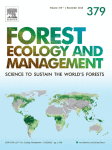Ver ítem
- xmlui.general.dspace_homeCentros Regionales y EEAsCentro Regional Buenos Aires SurEEA BalcarceArtículos científicosxmlui.ArtifactBrowser.ItemViewer.trail
- Inicio
- Centros Regionales y EEAs
- Centro Regional Buenos Aires Sur
- EEA Balcarce
- Artículos científicos
- Ver ítem
A comparison of five methods to assess embolism resistance in trees
Resumen
Vulnerability to drought-induced embolism is a key trait that shapes drought resistance and that could be increasingly used to design climate-smart forest management guidelines and to anticipate the outcome of climate change on populations dynamics and ecosystems functioning. A panel of methods is currently available to measure embolism resistance. This makes crucial a proper identification of which methods are the most accurate for determining this
[ver mas...]
Vulnerability to drought-induced embolism is a key trait that shapes drought resistance and that could be increasingly used to design climate-smart forest management guidelines and to anticipate the outcome of climate change on populations dynamics and ecosystems functioning. A panel of methods is currently available to measure embolism resistance. This makes crucial a proper identification of which methods are the most accurate for determining this trait. However, the measurement of embolism resistance is sensitive to numerous artifacts that may lead to large errors for a given species. In addition, not all methods are easily accessible because of the cost of some large equipment and/or certain lab facilities. The emergence of the easy and low cost Pneumatic method allows to perform vulnerability curves at high throughput. However, only few studies have evaluated the reliability of this method compared to others. In this study, we proposed a comparison of five methods that allowed to assess embolism resistance in eleven tree species with contrasting xylem anatomy and vessels length (six short vessel angiosperms, two tracheid bearing conifers and three long-vessel angiosperms), covering a large part of the range of embolism resistance observed in trees. Consistent results were obtained among all the methods for short-vessel angiosperm species. In tracheid-bearing conifers, the Pneumatic method overestimated
vulnerability to embolism. In long-vessel species, the Pneumatic method led to inconsistent results with accurate vulnerability to cavitation curves (VCs) for one species but led to r-shaped VCs with a underestimation of incipient embolism for the two other ones. The comparison of VC parameters with turgor loss point is proposed as
an indicator of the validity of the VCs. The conditions of validity, the advantages and pitfalls of the five methods are discussed. Our results warned against the widespread usages of some methods before rigorous validation tests have been performed
[Cerrar]

Autor
Sergent, Anne Sophie;
Varela, Santiago Agustin;
Barigah, T.S.;
Badel, E.;
Cochard, H.;
Dalla Salda, Guillermina;
Delzon, S.;
Fernandez, María Elena;
Guillemont, J.;
Gyenge, Javier;
Lamarque, L.J.;
Martinez Meier, Alejandro;
Rozenberg, P.;
Torres Ruiz, J.M;
Martin St Paul, N.K.;
Fuente
Forest Ecology and Management 468 : 118185 (2020)
Fecha
2020-04
Editorial
Elsevier
ISSN
0378-1127
Formato
pdf
Tipo de documento
artículo
Palabras Claves
Derechos de acceso
Restringido
 Excepto donde se diga explicitamente, este item se publica bajo la siguiente descripción: Creative Commons Attribution-NonCommercial-ShareAlike 2.5 Unported (CC BY-NC-SA 2.5)
Excepto donde se diga explicitamente, este item se publica bajo la siguiente descripción: Creative Commons Attribution-NonCommercial-ShareAlike 2.5 Unported (CC BY-NC-SA 2.5)

